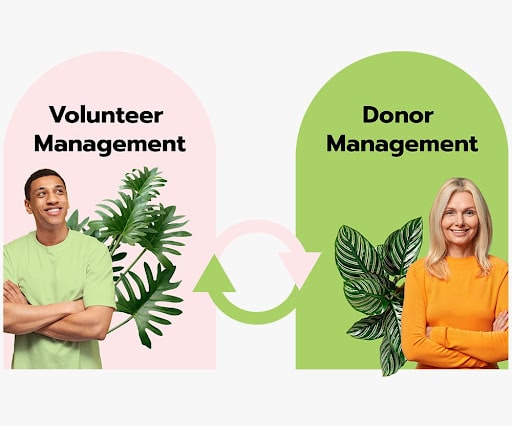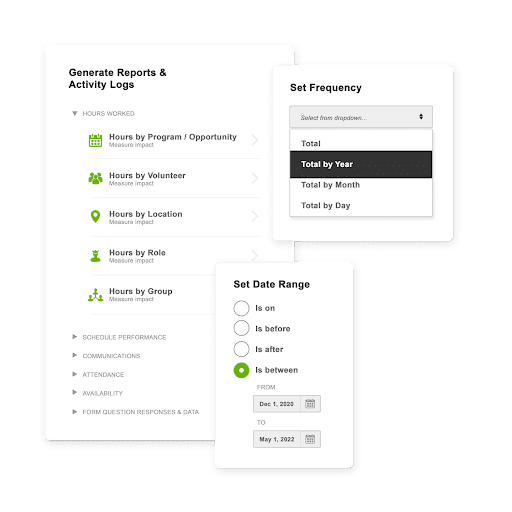Volunteer Management for Nonprofits: Top Tips and Strategies

Volunteer management is crucial to the continued success of most nonprofits. More than 60 million Americans volunteered in 2021, contributing $122.9 billion in economic value. Volunteers bring skills, dedication and, most importantly, passion to nonprofit organizations.
Proper volunteer management has the potential to grow your volunteer pool and foster retention, helping you maintain access to skilled, reliable support. In this guide, we’ll cover the core components of an effective volunteer management strategy, including:
- What is volunteer management?
- The volunteer management lifecycle
- Volunteer management best practices
- How volunteer management software can help
Let’s get started with the basics of volunteer management.
What is volunteer management?
Volunteer management is the process a nonprofit organization uses to recruit, track, engage and retain volunteers. Managing volunteers is key to developing and maintaining an effective, passionate and dedicated supporter base.
Proper volunteer management is important for nonprofits because it helps avoid excessive volunteer turnover. Because volunteers are unpaid, keeping them excited and incentivized can be challenging. Prioritizing volunteer management gives volunteers a sense of belonging within your organization, encouraging them to continue working to bring your vision to life.
The volunteer management lifecycle
The volunteer management lifecycle is the process volunteers go through during their engagement with your nonprofit, from when they’re first recruited to when they become recurring supporters.
When you understand the volunteer lifecycle, you can identify ways to improve your volunteer management processes at every stage. Here are the four steps of the engagement lifecycle:

Volunteer recruitment
Volunteer recruitment is the process your nonprofit uses to bring new volunteers on board. It includes marketing volunteer opportunities, allowing volunteers to sign up easily and screening potential volunteers.
Volunteer empowerment
Volunteer empowerment ensures that volunteers feel equipped and excited to get to work. By matching volunteers to jobs that suit their skill sets, giving them quality training and being available for questions during their shifts, you can empower your volunteers to do their best.
Volunteer engagement
Just as your organization uses donor communication to stay in touch and encourage repeat contributions, you must develop a volunteer communications plan to keep volunteers engaged. This should include methods used to deliver important volunteer information as well as avenues for volunteer feedback and questions.
Volunteer recognition and retention
We all appreciate being recognized for our hard work, and volunteers are no different. Recognizing your volunteers can involve anything from sending a thank-you note to offering them a free gift to giving them a shoutout in your monthly newsletter.
Similar to a donor appreciation event, a volunteer appreciation event can go a long way in showing your nonprofit’s appreciation for the hard work and dedication of your supporters and advocates — and it doesn’t have to be expensive or complicated. These events are meant to build trust and show appreciation, respond to volunteers’ questions and help demonstrate the alignment between your volunteers’ interests and passions with your organization’s mission.
Ultimately, when volunteers feel recognized and appreciated for their contributions, they’ll be much more motivated to stay involved with your organization for the long term.
Volunteer management best practices
Through every stage of the management process, your nonprofit has plenty of opportunities to better connect with volunteers, understand their motivations and provide a positive experience. Ultimately, volunteers will decide whether to stay involved with your cause based on their connection to your nonprofit. Use these best practices to improve your volunteer management approach:
Streamline your registration form
Your volunteer registration form should be simple and easy to fill out, no matter what type of device volunteers use. Ask only necessary questions, such as volunteers’ contact information (including their emergency contact), interests and availability. Use large text and buttons to make the form easy to read on mobile devices.
Make your registration form easy to find on your website by including it in your navigation menu and using calls to action (CTAs) on your homepage that lead to the form.
Write clear, compelling role descriptions
Your volunteer role descriptions should entice new volunteers to get involved and offer all the information volunteers need. Include details such as:
- The role’s title and responsibilities
- The date, time and location of the opportunity
- Any supplies or equipment volunteers should bring
- Benefits volunteers will receive from participating, such as the ability to meet new people or receive a complimentary branded t-shirt
- The link to the signup form
Post your volunteer description on social media, share it via email and publish it on volunteer hubs like VolunteerMatch to maximize your recruitment reach.
Recruit existing supporters
Reach out to current supporters to see if they’d be interested in joining your volunteer program. Send invitations to:
- Donors
- Peer-to-peer fundraisers
- Corporate partners
- Board members
These individuals have already expressed support for your mission and may be looking for new ways to get involved. Reach out with a personalized email or text addressed with recipients’ names to ensure that your message stands out.
Use multiple marketing channels to promote opportunities
Share your volunteer posting widely across your marketing channels, including:
- Social media
- Your website
- SMS communications
- Flyers
- Direct mail
A multichannel marketing strategy will help you reach the broadest possible audience. You can even ask current volunteers to invite their friends or family members to your opportunities, widening your reach to new audiences.
Gather feedback from volunteers
Show volunteers that you’re committed to building your program with their needs and interests in mind by asking for their feedback. Send surveys with questions like:
- What is your favorite part of our volunteer program?
- What is something you would change to improve our volunteer program?
- What is your preferred communication method to hear about volunteer opportunities?
- Do you feel like our volunteer opportunities work well with your schedule?
- Would you recommend our volunteer program to a family member or friend?
After receiving responses, outline a plan to adjust your program based on volunteers’ input. Communicate your plan to volunteers to show that you’re taking their recommendations seriously.
Don’t be afraid to cultivate volunteers as donors
Some nonprofit professionals hesitate to ask volunteers for donations. The idea is that volunteers already contribute plenty of support, so volunteer managers don’t want to overwhelm them with additional requests.
However, nonprofit volunteers often want to contribute financially alongside their volunteer work. According to the Global Trends in Giving Report, 76% of volunteers in the United States and Canada donate to the nonprofits they volunteer for.

Cultivating volunteers as donors starts with the following steps:
- Identify your most engaged volunteers
- Create a communications segment to send tailored messages to this group
- Illustrate the incredible impact volunteers have already made through their work
- Provide multiple donation options, including one-time donations, monthly giving, in-kind donations or gifts of stock
When you focus on building genuine relationships with volunteers, they’ll happily support your fundraising efforts in addition to their volunteer work.
How volunteer management software can help
Volunteer management software refers to tools volunteer managers can use to keep volunteer information, scheduling processes, communications and other activities organized.
Volunteer management software features
Just like your donor management system, it’s important to consider what features your organization needs most when choosing a volunteer solution. Here are a few must-have features to look for when researching volunteer management systems:
- Scheduling tools: Assign volunteers to projects and shifts, send shift reminders and identify scheduling gaps
- Volunteer profiles: Track volunteer history, contact information, interests, skills and other important information. Attach important documents to volunteer profiles, like background checks and waivers.
- Data reporting: Monitor volunteers’ progress through your training process, track volunteer hours and measure volunteer impact
- Communication tools: Message volunteers privately, offer a communications board and create communication segments for targeted messaging. Categorize your volunteers by availability, age, gender, geographical location, years of service and other characteristics of your team’s choosing.
- Software integration: Integrate volunteer management with donor management systems and email marketing tools
Any volunteer management system you consider should at least offer these essential tools. Many will also go above and beyond to ensure a positive user experience and better volunteer retention outcomes, such as our recommended provider below.
Our recommended volunteer management solution: Bloomerang Volunteer
Bloomerang’s volunteer management software, Bloomerang Volunteer, streamlines and automates repetitive tasks to give you more time back for building relationships with volunteers. You can centralize reporting processes and offer a better experience for both volunteers and staff.
Stand-out features of Bloomerang’s platform include:
- Two-way sync with your donor database to cultivate volunteers as donors and view all supporter engagements in one place
- A powerful volunteer scheduler that allows volunteer managers to create unlimited schedules, send shift reminders and track volunteer attendance
- Self-serve options for volunteers to easily choose the roles and shifts that work best for them
- A mobile app to simplify communication between volunteers and managers
Bloomerang also offers robust reporting tools, allowing volunteer managers to set up custom recurring reports and keep track of volunteer progress.

Does Bloomerang Volunteer sound like the right fit for your nonprofit’s needs? Schedule a volunteer management demo to learn more.
The bottom line
Intentional volunteer management is essential for any nonprofit organization. Recruit and retain valuable volunteers by crafting a plan that includes an effective system for managing volunteers.
Additional Resources:
- 9 Proven Volunteer Retention Strategies for Nonprofits. Ongoing retention is a key component of volunteer management. Explore the top volunteer retention strategies.
- 15+ Volunteer Appreciation Ideas to Build Relationships. Showing appreciation helps volunteers feel valued. This guide offers multiple ways to show your gratitude.
- 17 Top Volunteer Management Software Options for Nonprofits. Volunteer management software streamlines your administrative work, giving you more time back in your day. Discover the top 17 options for nonprofits.



